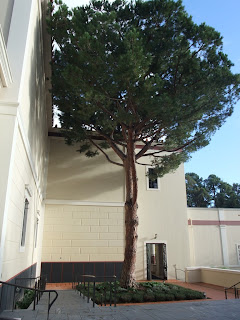We last left the intrepid Mr. Mouse and Ms. Town Mouse in Santa Barbara, on their way to L.A. The day after the Santa Barbara Botanical Garden visit, with a few packets of seeds tucked away in Ms. Town Mouse's pocket, they left right after breakfast. Because the kind hostess at the B&B had warned them, they avoided a landslide near Ventura and drove the quite possibly most windy road of the state over to the coast. The drive was through southern chaparral, a stunning sight in the mist.
But I'll let Town Mouse tell the story...
After a pleasant lunch with a friend in Malibu -- doesn't that name sound like vacation -- we were off to the Getty Villa at our appointed time. The visit is free (though parking is $15) but you need a reservation, and ours was at 1 p.m.
The Getty Villa is a restoration of a Villa at Herculaneum in Southern Italy. Mr. Getty built the villa to have space for artwork he wanted to show to the public. We found the collections of Greek, Roman, and Etruskan antiquities fascinating and interesting, but I was especially taken with the architecture and the gardens, and we took one of the free tours to learn more.
The garden mimics a Roman garden. Everything has a place and is orderly and symmetrical.
Fountains and statues make walking the gardens restful. Our guide explained that we should imagine the owner of the villa and his friend strolling in the garden, being inspired to great thoughts by statues of great philosophers.
Many of the plants in the gardens have symbolic value. For example, Acantus mollis (bear's breech) is associated with persistence and resilience. Even in a harsh, dry climate, Acantus remains green and beautiful (and can be quite invasive). You can see Acantus in the garden, and the leaves are also though to have been the inspiration for the Corinthian column capitals.
The villa also included a large kitchen garden with different types of herbs and fruit trees, carefully laid out in rectangular patterns. The walls of one of the garden would traditionally have been ornamented with ivy and laurel, but in the Getty Villa, the walls, as well as outside ceilings, were instead painted with flowers and greenery.
Because it's impossible to know how the gardens at Herculaneum really looked, the garden designer took inspiration from the symbolism of plants and included, for example, papyrus, the plant that was used to make paper in antiquity. You can see papyrus next to the fountain in the second picture above.
Most interesting was the last step in the garden tour, where the docent showed us this tree.
From this spot in the garden, the Herculaneum villa owner could have seen the vulcano that eventually obliterated both Herculaneum and Pompeii. Mr. Getty (or the garden designer) chose to plant a tree instead, symbolizing being rooted in the earth but reaching up high to the sky. The tree will eventually grow large completely shade that area, just as the looming vulcano in Herculaneum.
We were sorry to leave the beautiful villa with its magnificent art, stunning views, and interesting history. But we had one more stop on our trip and were ready to continue to Santa Monica.






Comments
Sorry I wasn't clear. In Italy, the vulcano shades the garden. In Malibu, there is no vulcano. Instead, a tree representing the vulcano shades the garden.
Yes, it was a great trip. I wish CMouse could have come along!
Makes me want to go to California again. After all, it is in my blood. It's where I was born.
Not quite true. Other than the ephemeral floral plantings which we know by pollen and pictorial evidence there are the casts made in the root cavities left by the dead plants that have been used to identify and replant many of the gardens.